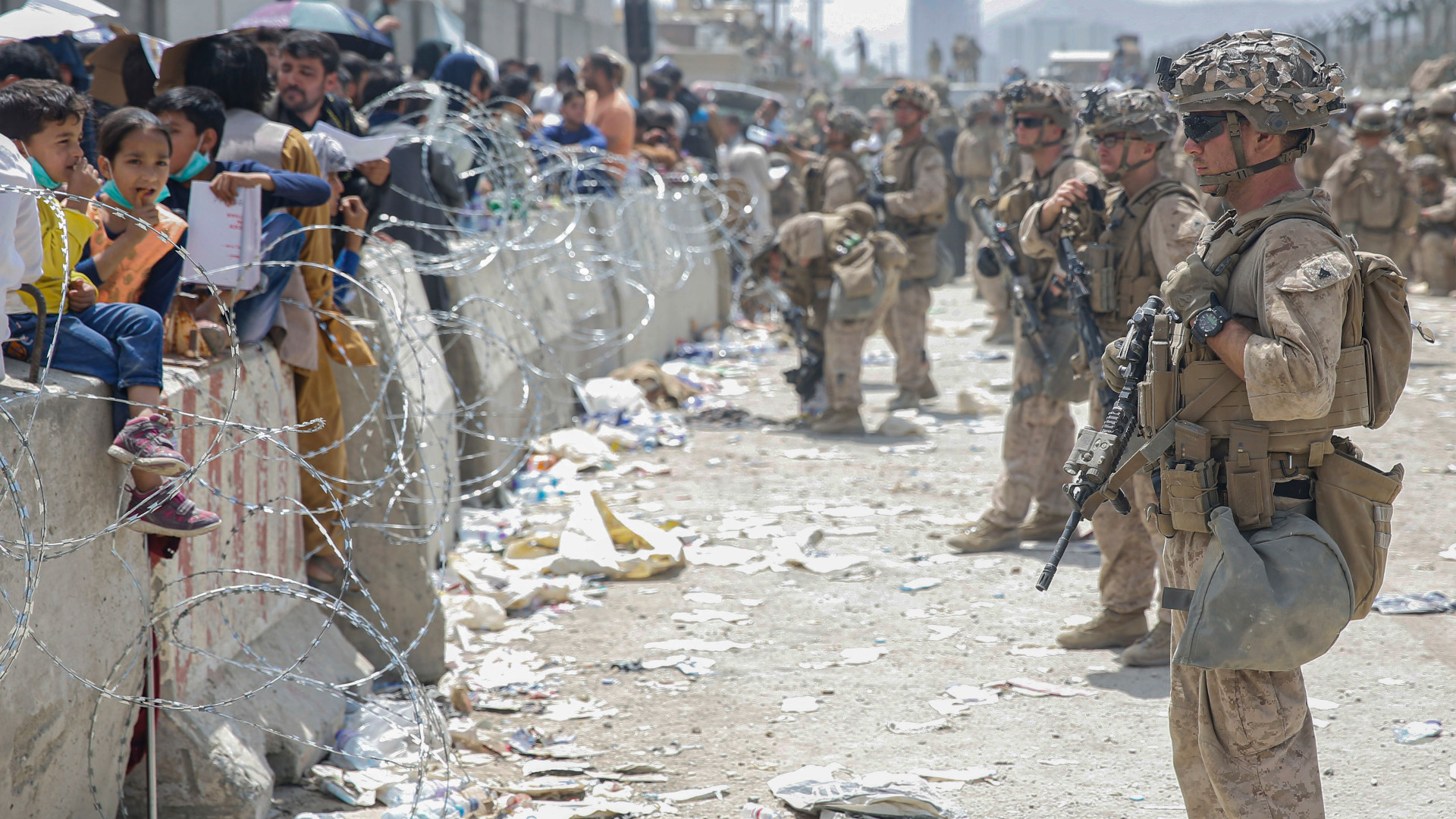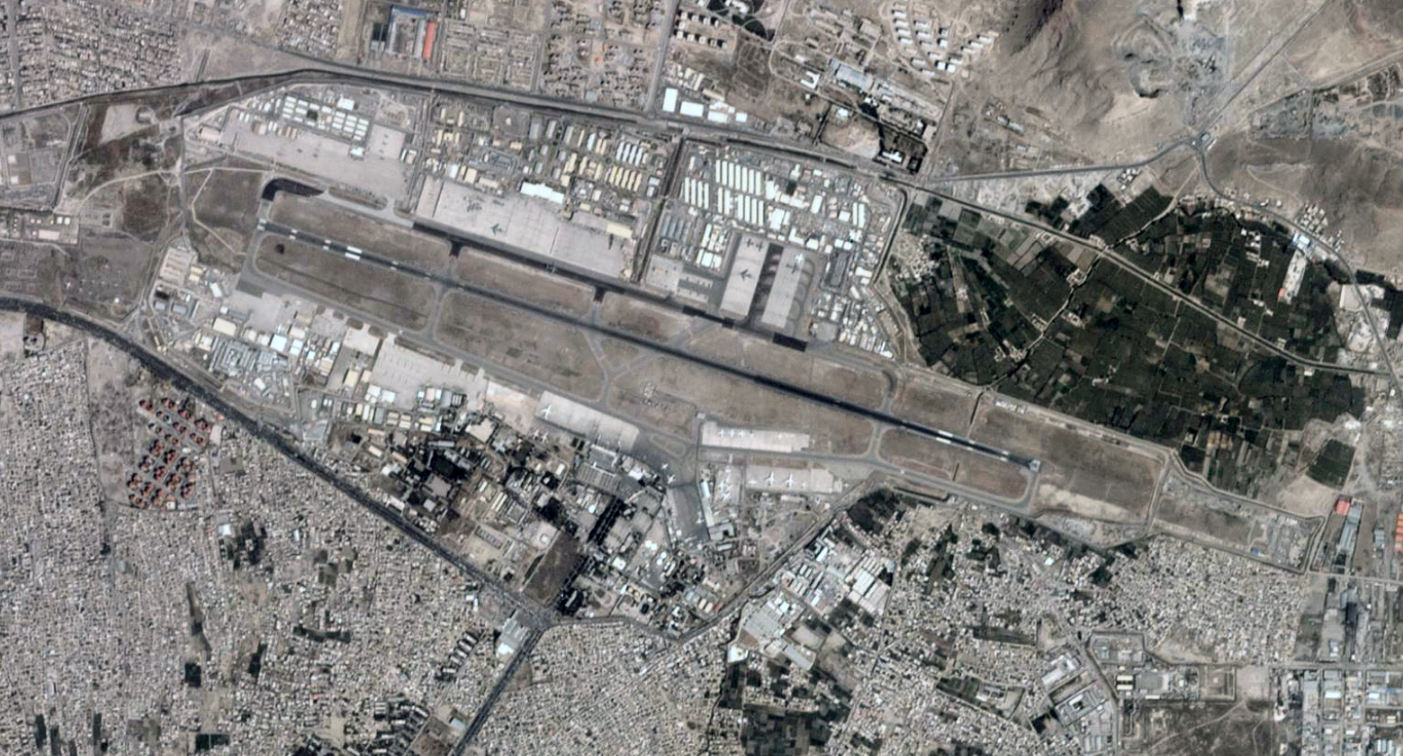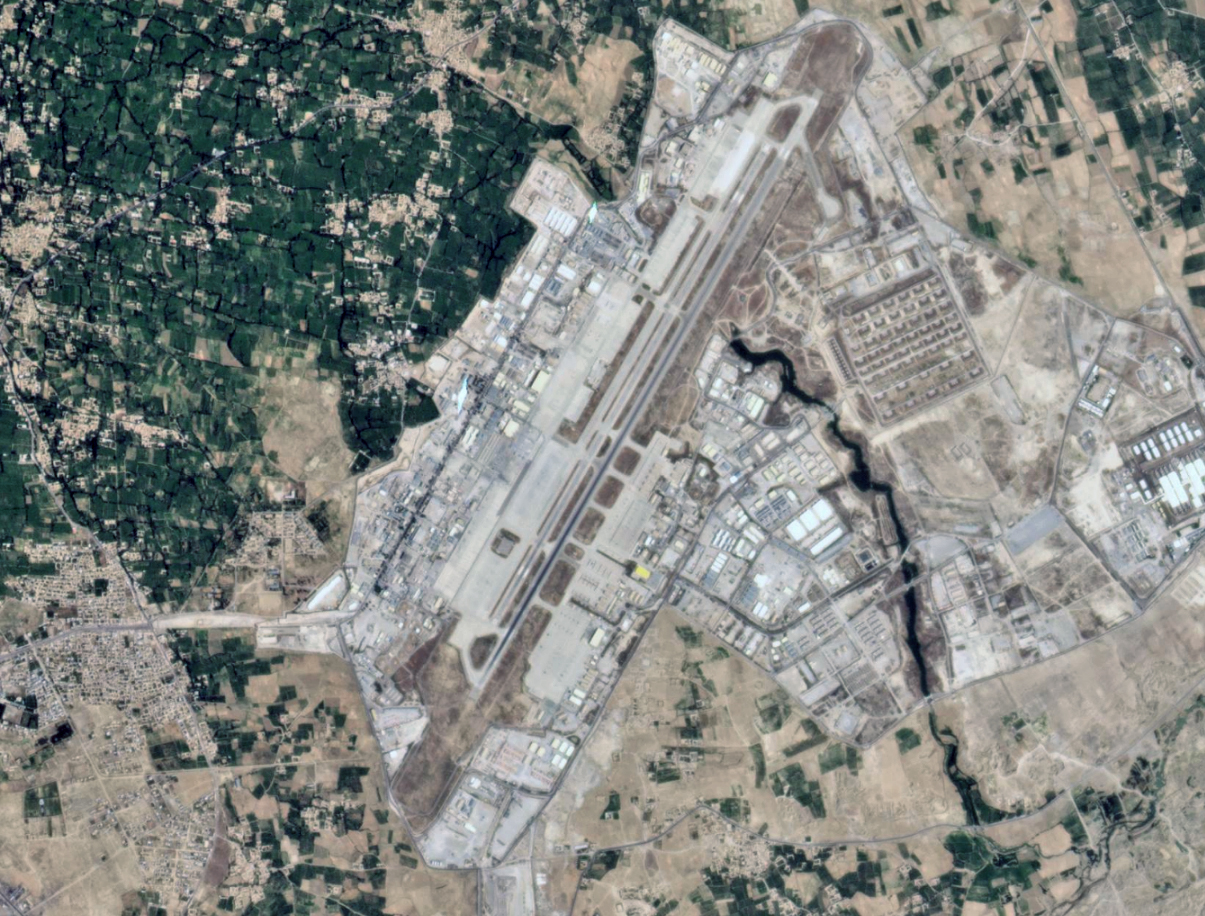Pentagon Press Secretary John Kirby downplayed the idea of U.S. forces potentially reopening Bagram Airfield, or other air bases in Afghanistan, to assist with ongoing evacuation operations in that country. This comes as a Taliban spokesperson has said the planned end of U.S. military evacuation operations at Hamid Karzai International Airport on Aug. 31 is a “red line” issue for the group and that any attempt to unilaterally extend the timetable would “provoke a reaction.”
Kirby, who speaking alongside U.S. Army Major General Hank Taylor, the Director of Current Operations within the Office of the Joint Staff, responded to a number of questions regarding the current timetable for U.S. military evacuation operations in Afghanistan at a briefing this morning. Hamid Karzai International Airport in Kabul, which is nestled inside a dense urban area, has just one runway, and relatively limited ramp space, is presently serving as the nexus for U.S. government-assisted evacuations, as well as those being carried out by various other countries. At least publicly, the Biden administration continues to plan to conclude the U.S. non-combatant evacuation operation (NEO) on Aug. 31.

“What you’re talking about would be an expenditure of resources, and personnel, as well as an increase most likely to the threat that they’re under to try to go back and … retake Bagram airbase, which is the size of a small city,” Kirby said. “It was closed down as part of the retrograde. It was always supposed to be closed down as part of the retrograde. It was the last base to be turned over to the Afghans.”
Kirby’s description of the size of Bagram, which American forces substantially expanded after 2001, underscores exactly why it could be so useful for supporting evacuation flights. The facility, which U.S. forces are intimately familiar with after having used it as a major hub for operations for nearly two decades, has two large runways and a host of other supporting infrastructure. Bagram, which is situated some 30 miles to the North of Kabul, also has the benefit of a much larger and more readily defensible perimeter that isn’t inside an urban area.


If Bagram could be opened and operated in a secure manner, even in a contested environment, it could be possible to shuttle in evacuees from Hamid Karzai International Airport, offering an immediate way to relieve the current logistical strains imposed by conducting evacuations flights from a single airport. In addition, the base could present a valuable fall-back location to continue evacuation operations should the security situation in Kabul continue to erode, and that could be maintained after Aug. 31.
The U.S. military vacated Bagram, which is situated to the north of Kabul, under extremely controversial circumstances at the beginning of July. Kirby stressed, as he had last week, that there had already been planning around the potential for conducting a NEO exclusively from Hamid Karzai International Airport just three weeks ago, before the beginning of the Taliban’s final, lightning-fast offensive across Afghanistan that culminated with the fall of Kabul on Aug. 15. Secretary of Defense Lloyd Austin had again defended the U.S. military’s responses to the situation in an interview with ABC News‘ Martha Raddatz yesterday, saying “I do” in response to a question about whether he felt “the planning was acceptable and appropriate.”
Kirby did not respond directly to questions about whether it might be possible to work with the Taliban, via the Pakistani or Qatari governments, to reopen other airfields across Afghanistan for evacuation flights. When asked, he also did not confirm or deny a report that the White House had scrapped a plan for elements of the U.S. Army’s 82nd Airborne Division to parachute into Bagram, seize it, and then reopen it to support the ongoing NEO.
Online flight tracking data last week and over the weekend showed U.S. Air Force E-11A Battlefield Airborne Communications Node (BACN) aircraft, powerful tools for connecting personnel on the ground to aircraft flying above, orbiting directly around Bagram on at least two separate occasions. This had prompted speculation about a potential plan for American forces to reopen that base.
It is also worth noting that continency response elements of the 82nd Airborne already make up a significant number of the approximately 5,800 U.S. troops now deployed to Hamid Karzai International Airport to support the ongoing evacuations. The U.S. Marine Corps’ Special Purpose Marine Air-Ground Task Force – Crisis Response – Central Command (SPMAGTF-CR-CC), another go-to force for crises in the region, has also sent personnel to support the evacuations from the airport in Kabul. All of this limits the number of high-readiness elements that the U.S. military could call upon for any additional missions.
Though not mentioned at the briefing, the Army does also has the 173rd Airborne Brigade based in Italy. This unit has a standing mission to be prepared to conduct contingency response missions in the U.S. Central Command area of responsibility, which includes Afghanistan. At the same time, it is also one of the primary contingency response forces that the U.S. military can call upon for operations in Europe and Africa, which could impact the decision to deploy it in this case. It’s not clear how many of the brigade’s almost 4,000 troops may be in a position to deploy on short notice, at all, as well.
There have already been persistent questions about the U.S. military’s ability to successfully complete the planned NEO before Aug. 31. A host of security, logistical, and bureaucratic issues have continued to hamper the evacuation operations, at times grinding them to a halt entirely, since the effort began in earnest following the fall of Kabul to the Taliban just over a week ago.
The Pentagon has been working to speed up evacuations out of Kabul and Major Hank Taylor said today that 16,000 people had departed via Hamid Karzai International Airport in the past 24 hours, 11,000 of which were on flights facilitated by the U.S. government. That is a tempo of operations that is higher than the U.S. military had previously expected it would be able to reach, having originally set a goal of being able to move between 5,000 and 9,000 people out of the country every day.
In addition, yesterday, the Pentagon announced the activation of the Civil Air Reverse Fleet, a mechanism through which the U.S. military can compel commercial airlines and charter services to provide aircraft to support contingency operations that you can read more about in detail here. A total of 18 commercial planes are now set to assist in the movement of evacuees from intermediate staging locations to more permanent destinations, including facilities in the United States. A backlog in the processing of Afghan evacuees at Al Udeid Air Base in Qatar has a cascading impact on the entire airbridge last week, leading to a complete stoppage of all flights out of Hamid Karzai International Airport for eight hours, underscoring many of the challenges still facing the entire enterprise.
Defense One reported earlier today that the U.S. Air Force, alone, has airlifted more than 30,000 people, in total, out of the country. However, there are an estimated 20,000 people still at Hamid Karzai International Airport waiting for evacuation flights. Thousands more American citizens and Afghans who would be eligible to evacuate with American assistance are elsewhere in the country. It has proven to be hard, if not perilous, to travel within Kabul to the airport, let alone get there from outside of the city. Throngs of average Afghans trying to flee the country by air continue to gather outside the airport, as well.
This has led to growing calls from within the United States, as well as from America’s allies and partners, to extend the evacuation timetable. Unfortunately, a Taliban spokesperson has now said that the group will not allow this to happen.
“It’s a red line. President Biden announced that on 31 August they would withdraw all their military forces,” Suhail Shaheen, a Taliban representative at the group’s political office in Doha, Qatar told Sky News earlier today. “So if they extend it that means they are extending occupation while there is no need for that.”
“If the U.S. or U.K. were to seek additional time to continue evacuations – the answer is no. Or there would be consequences,” he continued. “It will create mistrust between us. If they are intent on continuing the occupation it will provoke a reaction.”
Pentagon Press Secretary Kirby declined to say what the U.S. government’s plans might be force extending evacuation operations beyond Aug. 31 might be at present, but he insisted that the goal remained to conclude the mission by the end of the month. He also said that “we all understand that view” in response to Shaheen’s “red line” comments and said that the U.S. military was in “constant coordination and deconfliction” with the Taliban in Kabul to work on getting people safely to the airport.
Kirby also revealed that the U.S. military had carried out a second operation to recover Americans outside of the airport using unspecified helicopters, but declined to elaborate further. He also indicated that teams on the ground were conducting similar rescue missions on a case-by-case basis.
Last week, the Pentagon had disclosed that it had extracted 169 Americans from a hotel in Kabul using a trio of Chinook helicopters. Another mission involving American helicopters, as well as allied forces, was also reportedly launched to rescue an Afghan officer and their family. There is a contingent of helicopters from the U.S. Army’s elite 160th Special Operations Aviation Regiment at Hamid Karzai International Airport now, which, together with other special operations forces, would be ideally suited to these kinds of missions, as you can read more about here.
British, French, and German forces have also been leaving the airport to help retrieve people from elsewhere in Afghanistan’s capital and bring them back to the airport. Troops from a number of other countries are also operating at the airport.
General security in and around the airport remains a concern, as well. Earlier today, at least one former member of the Afghan government’s security forces now helping provide security at Hamid Karzai International Airport was killed, and others were wounded, when an unknown gunman or gunmen opened fire on a position outside the north gate. U.S. and German forces were also involved in the ensuing firefight, but sustained no casualties. It remains unclear if the hostile armed individual or individuals involved were members of the Taliban, but this is the second such incident in the past week. Over the weekend, there were also reports of intelligence indicating the potential for ISIS’ franchise in Afghanistan to try to launch terrorist attacks in Kabul, including at the airport.
With all this in mind, additional questions have emerged about whether smaller foreign military contingents will be able to continue their own operations after the last U.S. forces leave Kabul, whenever that might occur. U.K. Defense Secretary Ben Wallace told the BBC today that the departure of American troops would mean the end of the British mission.
“I don’t think there is any likelihood of staying on after the United States,” Wallace said. “Even if their timetable extends, even by a day or two, then that will give us a day or two more to evacuate people, because we are really down to hours now, not weeks, and we have to make sure we exploit every minute to get people out.”
In addition, it’s important to remember that the U.S. military will have to begin drawing down its current presence at Hamid Karzai International Airport before the official last day of operations and that evacuations would be similarly curtailed. Pentagon Press Secretary Kirby declined to say, given the current Aug. 31 deadline, whether or not actual evacuation flights could end up halted as early as this coming Saturday.
Whatever the case may be, there is only a little over a week left in the U.S. evacuation timetable, as it stands now. Whether the Taliban can be convinced to allow for an extension of any kind, and keep to any such agreement, is unclear. It is worth remembering that the group was opposed to the Biden administration’s original extension of the overall drawdown plan beyond the original deadline in May, as had been agreed upon by the previous Trump administration, earlier this year, but largely acquiesced to it. At the same time, the Taliban was still an insurgent force when that extension plan was announced, not the de facto government of the country, as it is now.
All told, the future of the U.S. military’s ongoing evacuation operations, and those of its allies and partners, is increasingly uncertain, as is whether or not thousands of people still looking to escape the country, including Afghans fleeing the Taliban’s rule, will be able to get out safely.
Update 4:00 PM EST:
U.S. Army General Steve Lyons has said at a separate press briefing today that “the threat is significant” to aircraft arriving and departing from Hamid Karzai International Airport in Kabul.
General Lyons also provided additional details about the sheer scale of the current evacuation effort. He disclosed that a total of three babies have now been born on evacuation flights, as well. The U.S. Air Force disclosed one such birth over the weekend.
Contact the author: joe@thedrive.com
